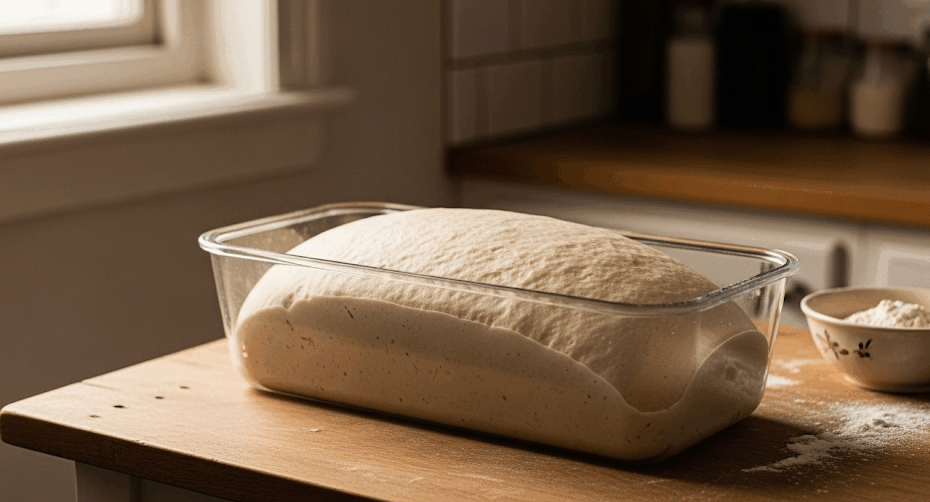Part 4: Bulk Fermentation – The First Big Rise
You’ve done the heavy lifting and built a strong foundation. Now, you hang up your trainer hat and become a patient observer. Welcome to Bulk Fermentation—the first rise. This is the single most critical stage, where time and temperature conjure up the flavor, structure, and soul of your bread.
Your job during this phase? Be a good babysitter. Provide a warm environment and a little bit of structure (through folds), and then get out of the way and let the yeast and bacteria do their thing.
The Science Bit: A Three-Ring Circus in Your Dough
During bulk fermentation, your dough is a bustling microbial metropolis.
- Leavening (The Rise): The yeast you’ve cultivated is now feasting on the flour’s sugars and producing a massive amount of CO2. This gas gets trapped by the gluten network you so painstakingly built, causing the dough to inflate. This is the “rise” you can see.
- Flavor Development (The Good Stuff): The Lactic Acid Bacteria (LAB) are also having a party. They are producing the organic acids (lactic and acetic) that give sourdough its signature tangy, complex flavor. The longer and slower this fermentation, the more flavor develops. This is the magic you can taste.
- Dough Maturation (The Structure): The acids produced by the LAB also have a secondary effect: they help to strengthen the gluten network, making the dough more elastic and mature. This is the structure you can feel.
The Two Pillars of Bulk Fermentation: Time and Temperature
This whole process is a dance between time and temperature.
- Temperature is the accelerator pedal. A warmer dough (e.g., 78-82°F / 25-28°C) will ferment much faster. A cooler dough will ferment much slower. Consistency is key. Find a warm spot in your house, or create one using a proofing box or your oven with the light on (and the door cracked).
- Time is a suggestion, not a command. A recipe might say ‘let rise for 4 hours,’ but this is just an estimate based on the author’s kitchen. Your dough is ready when it tells you it’s ready. You have to learn to read the dough, not the clock.

The Technique: Stretch and Folds
Instead of one long kneading session at the beginning, we use a series of gentle “stretch and folds” during the first half of bulk fermentation. This is a game-changer.
Why do it?
- Strengthens Gluten: It realigns and strengthens the gluten network without oxidizing the dough.
- Evens out Temperature: It redistributes the warmer and cooler spots in the dough for more even fermentation.
- Redistributes Food: It moves the yeast and bacteria to new areas of the dough with fresh sugars to feast on.
How to do it:
- About 30-45 minutes after you finish mixing, it’s time for the first set.
- With a wet hand, reach down the side of the bowl, grab the underside of the dough, stretch it upwards gently, and fold it over the top of the dough.
- Rotate the bowl a quarter turn and repeat.
- Do this a total of 4 times (one for each “side”). That’s one “set” of folds.
- Cover the dough and let it rest.
- Repeat this process every 30-45 minutes for the first 2-3 hours of bulk fermentation.Pro Tip: Pay close attention to how the dough feels with each set. At first, it might feel slack and weak. By the last set of folds, it should feel much more cohesive, smooth, and full of life, resisting your stretch just a little. That’s how you know it’s working!
How Do I Know When It’s Done? Reading the Dough
This is the hardest skill for a new baker to learn. Forget the clock and look for these signs:
- Significant Volume Increase: The dough should have increased in size by about 30-50%. Don’t look for it to double! Over-proofing is the enemy.
- A Domed Surface: The top of the dough should be smooth and domed, maybe with a few bubbles appearing.
- A Lively Jiggle: If you gently shake the bowl, the whole mass of dough should move with a distinct wobble, like a giant, delicate water balloon. A dough that is not ready will feel more dense and solid. This jiggle is a clear sign that the dough is aerated and full of gas.
- Webs on the Side: When you pull the dough away from the side of the bowl, you should see web-like gluten strands.
When you see these signs, bulk fermentation is over. Resit the urge to let it go “just a little longer.” It’s time to divide and shape our beautiful, airy, flavorful dough.
Next Up: Part 5: Divide & Conquer – Preshaping Your Dough →
Or jump directly to your favorite part:
- Pretzel & Rye Beginner’s Guide – Part 1: Taming the Yeast Beast (Your Sourdough Starter)
- Pretzel & Rye Beginner’s Guide – Part 2: The Autolyse – Giving Your Flour a Spa Day
- Pretzel & Rye Beginner’s Guide – Part 3: Mixing & Kneading – The Great Gluten Workout
- Pretzel & Rye Beginner’s Guide – Part 4: Bulk Fermentation – The First Big Rise
- Pretzel & Rye Beginner’s Guide – Part 5: Divide & Conquer – Preshaping Your Dough
- Pretzel & Rye Beginner’s Guide – Part 6: The Final Shape – From Blob to Boule
- Pretzel & Rye Beginner’s Guide – Part 7: The Final Proof – The Beauty Sleep
- Pretzel & Rye Beginner’s Guide – Part 8: The Grand Finale – Baking Your Loaf
- Pretzel & Rye Beginner’s Guide – Part 9: The Afterglow – Storing, Freezing & Reviving Bread
